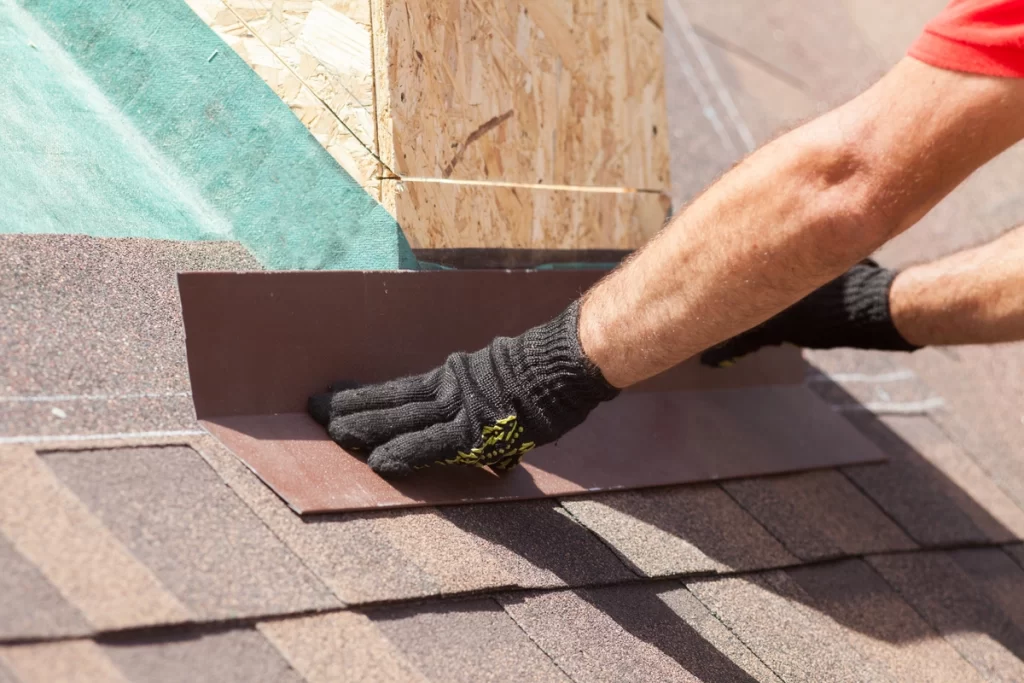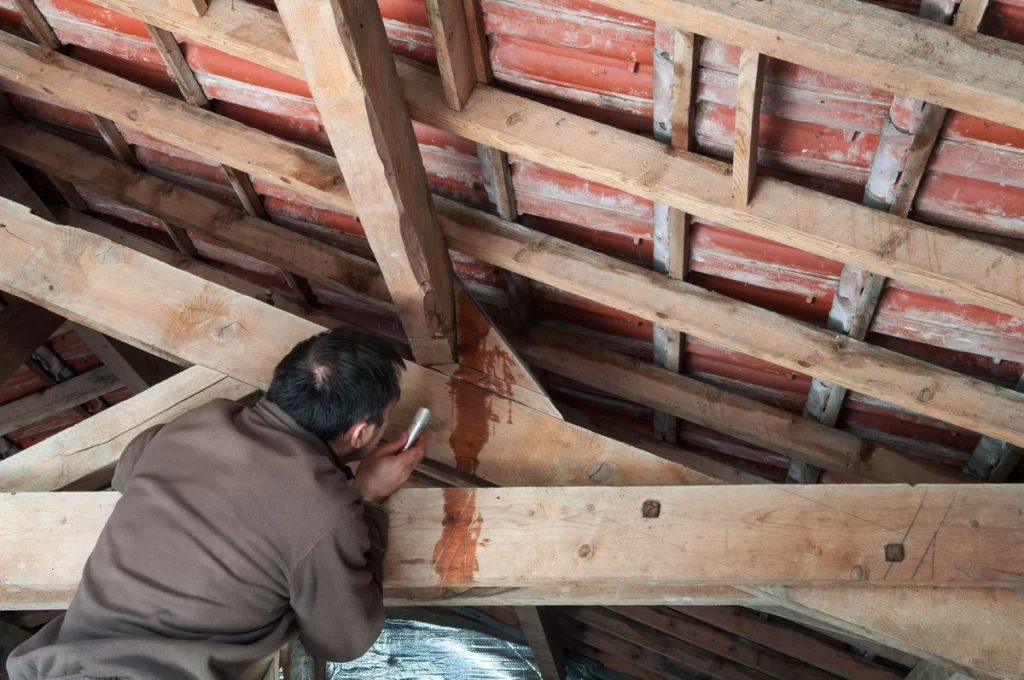If you clicked on this article, we’d wager that you’ve found yourself in a sticky situation. If you’ve noticed a leak in your ceiling and more rain is in the forecast, it’s vital to act fast.
Leaky roofs can quickly turn into larger, more expensive issues that compromise the integrity of your home if you delay action. Ideally, a professional roofing contractor will be able to stop by and perform an emergency roof repair, but if that isn’t possible, there are some steps you can take to temporarily stop your roof from leaking.
Step 1: Call Local Roofing Companies

The first step you should always take when you need emergency roof repairs is calling around to trusted local roofing companies and asking if they offer 24/7 or after-hours emergency repair services.
Typically, if a roofing contractor can stop by for an emergency repair, they will place a tarp over the affected area or perform a temporary patch job on the leak until they can come back soon and perform complete repairs.
Keep in mind that if your roof leak is happening during a storm, you might be out of luck with professional emergency roof repairs because roofers may already be completely booked to help out other homeowners in the same situation. If this is the case, keep reading to learn the steps you can take to stop the leak yourself.
Step 2: Catch the Water With a Bucket
A leaking roof can quickly cause water damage to your home’s interior if the situation isn’t dealt with. In a roofing emergency, you’ll need to attempt to catch as much water as possible and keep it away from your home’s walls, ceiling, and floors.
A frustrating fact about roof leaks is that they frequently spread out over the ceiling, and they rarely drip down in one localized area. This can cause extra damage to the point of your ceiling collapsing.
If you notice that the leak is causing the ceiling drywall to sag, the best plan of attack is to poke a hole in the center of the area with a pencil. Place a bucket underneath the hole so that the water can pour through one area and into the bucket.
Even if your roof leak isn’t too dramatic, be sure to place a bucket under the dripping water so that you can avoid water damage to your floors.
Step 3: Determine Where the Leak Is Coming From
 If a roofer can’t stop by on an emergency basis, you’ll need to temporarily take the situation into your own hands.
If a roofer can’t stop by on an emergency basis, you’ll need to temporarily take the situation into your own hands.
Roof leaks can be caused by a few situations, but most commonly they’re caused by storm damage or improper installation. You may hear some water dripping or notice a water stain on your ceiling, but can’t quite track down where the roof leak is coming from.
It’s important to figure out the source of the leak before moving on to any other steps so that you aren’t wasting your time and money aimlessly patching areas that aren’t the issue.
There are a few different ways to find the source of a roof leak:
- Go in the attic while it’s raining and find the entry point.
- Get on your roof and see if anything is penetrating the roof’s surface. (Be sure to follow roofing safety tips and never go on your roof when it’s raining.)
- Go in your attic and look for any wood rot or damage.
- If it’s not raining, spray a water hose on the roof. Have someone in the attic to watch for water leaking.
- Walk around your property and look for any missing shingles.
It’s important to remain as calm as possible as you search for the source of your roof leak. You don’t want to do anything reckless that causes you to get hurt. Usually, by the time you spot a roof leak, the damage has already been done. So, as long as you follow these steps to minimize any further damage, you’ll be okay until a professional can help.
Step 4: Choose Your Method for Patching the Leak
Once you find the source of the leak, you can perform a temporary fix. There are a handful of methods homeowners can use to patch a roof leak. However, some of them, like replacing shingles or replacing roof flashing are far too complicated for anyone to try without experience, especially in an emergency situation.
For our purposes, we’ll be focusing on the safest and simplest patching methods homeowners can try:
- Use a tarp to cover the area: You can find tarps at most home improvement or hardware stores. You’ll want to lay the tarp taut over the leak and either nail the tarp into your shingles or use heavy wood beams to hold it down. Or both! This is the simplest temporary fix for homeowners.
- Use roof cement to patch the roof: You can find roof cement at hardware stores, and this trick is best used on a dry roof. Brush away debris from the hole or crack and fill the area with roofing cement.
- Use caulk or a rubber sealant coating to stop the leak: If the leak source is a small hole, you can fill the hole with caulk or rubber sealant.
Step 5: Make Sure a Professional Roofer Is Stopping by ASAP
Even if you’ve successfully stopped your roof leak, it’s still vital to have a professional licensed contractor stop by as soon as possible. If they weren’t able to come on an emergency basis, be sure to schedule an appointment for them to stop by for roof repairs in the coming days.
Professional, permanent repairs will stop any further water damage in its tracks. Plus, if your leak was caused by a storm, a professional roofer can assess the damage and help you file an insurance claim!
Get In Touch With Monarch For Emergency Roof Repair Services
Living in the Carolinas comes with the guarantee of many storms. The professional and responsive team at Monarch Roofing is dedicated to providing roof leak repairs and helping homeowners file insurance claims.
If you have a leaky roof, don’t wait to address the problem. Ignoring a small leak can lead to bigger problems down the road, including water damage to your home’s interior and the growth of mold and mildew.
When it comes to your home, you deserve expert care that keeps you safe. Contact Monarch Roofing whenever you have a leak or any other storm damage!





